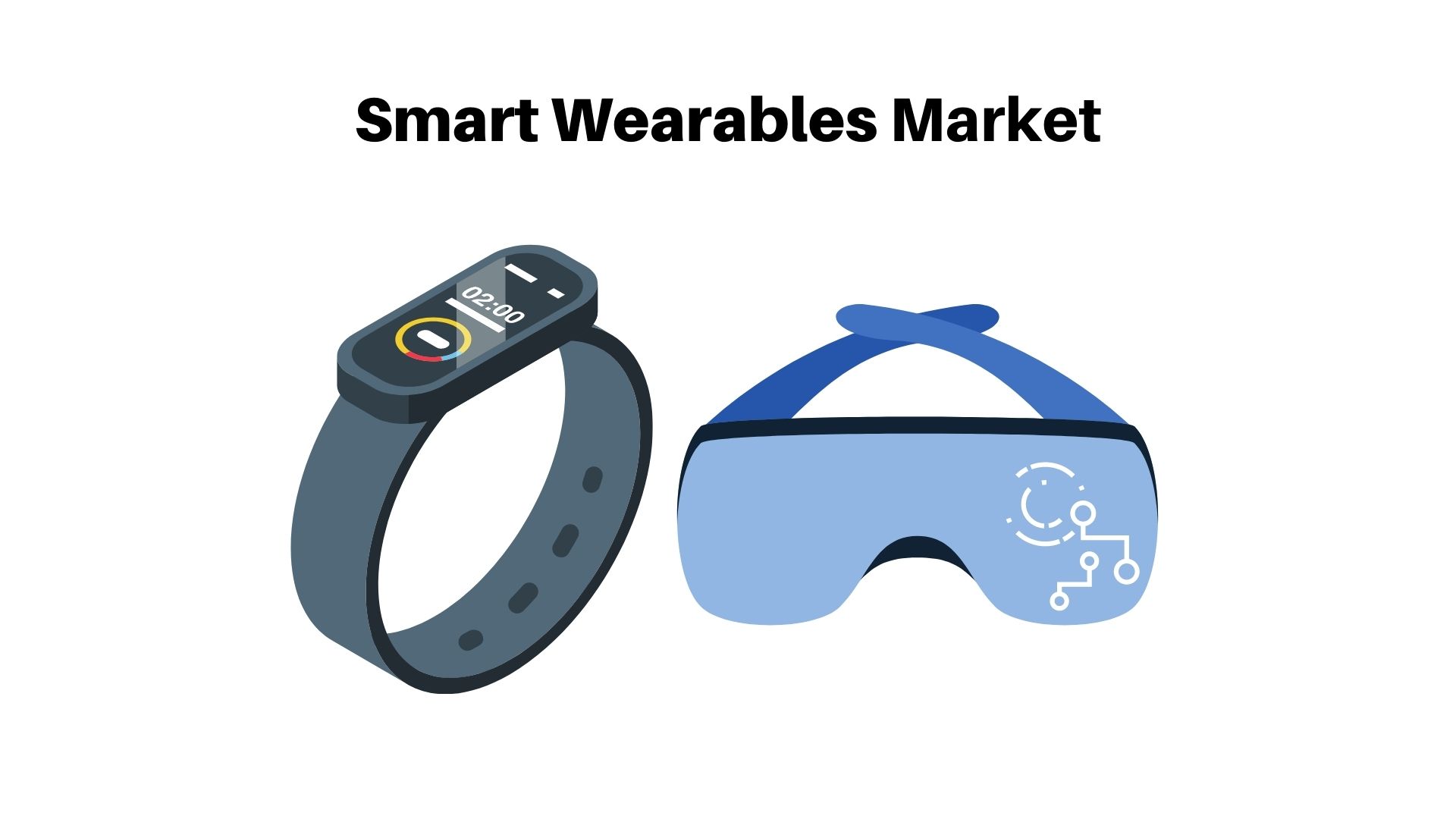Smart Wearables Market Will Projected To Reach USD 135.96 billion by 2032

Page Contents
Market Overview
Published Via 11Press: The Smart Wearables market is a rapidly developing sector of the electronics industry. This sector encompasses various wearable devices like smartwatches, fitness trackers, smart glasses, and clothing as well as other connected items.
According to Market.us' report, the global Smart Wearables market size was valued at USD 32.18 billion in 2022 and is expected to reach a whopping USD 135.96 billion by 2032, expanding at an impressive CAGR of 15.5% during this forecast period.
The growing adoption of smartwatches and fitness trackers is a major factor propelling the growth of the Smart Wearables market. These devices offer features such as heart rate monitoring, GPS tracking, and fitness tracking which have become increasingly popular among consumers seeking to lead healthier lifestyles.
The growing adoption of smart glasses and other wearable devices in enterprise markets is fueling growth in this market. Industries such as manufacturing, logistics, and healthcare are increasingly using these glasses to enhance worker productivity and safety.
Request For Sample Report Here: https://market.us/report/smart-wearables-market/request-sample

Regional Snapshot
- North America is the leading market for smart watches and other wearables, and is expected to maintain its dominance due to the rising popularity of smartwatches and fitness trackers among customers.
- Europe has emerged as a major market for smart watches. Wearable technology is becoming more widely adopted in healthcare and fitness applications, while fashion-oriented items are on the rise. Forecasts predict steady growth for this region over the coming years.
- Smartwatch sales are expected to experience the fastest growth in Asia-Pacific due to factors like rising urbanization, increasing disposable income and growing awareness about health and fitness. China, India and Japan are key markets in this region for this phenomenon.
- Latin America is becoming a leader in smart watches. A growing number of consumers in the region are seeking wearables that track their health and fitness levels, with Mexico and Brazil being two key markets leading the way.
- The Middle East/Africa region's smart wearables market is expected to experience moderate growth over the forecast period due to increasing adoption of wearable technology in healthcare and fitness, as well as government initiatives that promote digital wellness.
Drivers
- Health and Fitness Awareness. As consumers place more emphasis on their health and fitness, they are looking for wearables that can monitor their exercise, track their vital signs and give them insights and suggestions to improve their overall well-being.
- Technology Developments: Smart wearables are now smaller, more efficient, and more versatile thanks to the rapid advances in technology.
- Growing Demand for Convenience: Smart Wearables Offer Users a Convenient and Hands-Free Way to Access Information, Receive Notifications, and Control their Smart Devices, All while on the Move
- Growing Smartphone penetration
- Integration with AI and Machine Learning: Advancements in artificial intelligence and machine learning technologies have enabled smart wearables to learn from and adapt according to users' behaviors and preferences, offering personalized recommendations and insights.
- Fashion and Design: As customers increasingly seek wearable devices that offer both functionality and personal style, manufacturers are paying greater attention to the aesthetics of their products, providing a range of designs, colors, and materials to choose from.
Restraints
- High Cost: Smart wearables tend to be more costly than traditional wearables, which may prevent price-sensitive consumers from investing in them.
- Limited Battery Life: Most smart wearables have a limited battery life, meaning users must charge them frequently. This can be inconvenient for those who are constantly on the go and require their devices to remain powered up at all times.
- Security and Privacy Concerns: As smart wearables collect and transmit sensitive personal data, there are concerns around security and privacy – particularly with regard to the storage and use of this data.
- Limited App Ecosystem: The smart wearables market is still young, and as such the app ecosystem for these devices is still developing. This may limit their functionality and usefulness for some users.
- User Comfort: Some smart wearables, particularly those worn on the body for extended periods of time, may be uncomfortable to wear and this could prevent some users from adopting them.
- Limited Compatibility: Some smart wearables may not be compatible with all devices or operating systems, which could prevent their adoption by those with specific device or software preferences.
Opportunities
- Healthcare Applications: The healthcare sector is seeing an increasing demand for smart wearables. These include remote patient monitoring, telemedicine and clinical trials. Smart wearables have the potential to significantly improve patient outcomes and cut healthcare costs by enabling more healthcare organizations to adopt digital solutions.
- Enterprise Applications: Smart Wearables offer a range of applications in enterprise settings, such as logistics, manufacturing and field services to enhance worker safety and productivity. Smart wearables enable workers to have hands-free access and communication with information, helping organizations reduce costs while streamlining operations.
- Smart Home Integration: As smart home technology becomes more commonplace, wearables could play an increasingly important role in controlling and monitoring devices. Connected to home automation systems, these wearables give users more control over their home management processes – providing greater convenience and comfort.
- Gaming and Entertainment: Smart wearables are becoming more widely utilized in the entertainment and gaming industries to offer immersive, multi-sensory experiences. Wearable technology such as smart glasses or virtual reality headsets has the potential to revolutionize these industries and open up new business opportunities for those involved.
- Fashion and Luxury: Smart wearables have been integrated into fashion accessories, luxury jewelry, and clothing to provide customers with utility-driven aesthetics. This hybrid approach to growth offers many industries new opportunities to expand, while simultaneously creating attractive new products.
View Detailed TOC of the Report | https://market.us/report/smart-wearables-market/table-of-content/
Challenges
- Fragmented Market: The smart wearables market is highly fragmented, with many manufacturers offering a diverse selection of products. This makes it difficult for customers to select the appropriate device and may prevent standardization across features and specifications across different models in the marketplace.
- Product Lifecycle: The product lifecycle for smart wearables is relatively short, with new products and features released frequently. This may make it difficult for consumers to stay abreast of the most recent technology and may restrict their adoption of new devices.
- Limited Battery Life: The limited battery life of smart wearables can be a serious drawback, particularly for devices that require frequent charging. This restricts their convenience and usability for those who are constantly on the go.
- Privacy and Security Concerns: As smart wearables collect and transmit sensitive personal data, privacy, and security have become top of mind. Manufacturers must ensure their devices are secure, protecting user data from unauthorized access or use.
- Compatibility Issues: Smart wearables may not be compatible with all devices or operating systems, which could restrict their adoption by those with specific device or software preferences.
- User Comfort: For prolonged wear of smart wearables, especially those worn on the body, comfort is key. Poor design or construction can lead to discomfort which in turn may prevent some from taking advantage of these devices.
Key Market Segments
Type
- Fitness Band
- Smart Watches
- Smart Glasses
Application
- Fitness and Wellness
- Infotainment
Key Market Players
- Fitbit
- Xiaomi
- Apple
- Garmin
- Samsung
- Jawbone
- Jawbone
- Polar
- Moto
- Huawei
- BBK(XTC)
- Lifesense
- Razer
Report Scope
| Report Attribute | Details |
| The market size value in 2022 | USD 32.18 Bn |
| Revenue forecast by 2032 | USD 135.96 Bn |
| Growth Rate | CAGR Of 15.5% |
| Regions Covered | North America, Europe, Asia Pacific, Latin America, and Middle East & Africa, and Rest of the World |
| Historical Years | 2017-2022 |
| Base Year | 2022 |
| Estimated Year | 2023 |
| Short-Term Projection Year | 2028 |
| Long-Term Projected Year | 2032 |
Recent Developments
- Enhancing Health & Fitness Focus: Manufacturers are introducing features such as blood oxygen monitoring and sleep tracking to help users make better decisions regarding their lifestyle choices. These tools will empower users to make healthier choices about their health and fitness routines.
- Integration with Virtual Assistants. Smart wearables have become increasingly integrated with virtual assistants such as Amazon Alexa and Google Assistant, enabling users to control and access their smart home devices, find information, and complete other tasks using voice commands.
Frequently Asked Question
Q: What is the current market size for the Smart Wearables Market?
A: According to a report by Market.us, the Smart Wearables Market was valued at USD 32.18 billion in 2022 and is expected to reach USD 135.96 billion by 2032, growing at a CAGR of 15.5% during the forecast period.
Q: What are the key segments of the Smart Wearables Market?
A: The Smart Wearables Market can be segmented based on Type (Fitness Bands, Smart Watches, Smart Glasses), By Application (Fitness and Wellness, Infotainment), and geography (North America, Europe, Asia-Pacific, Latin America, and Middle East & Africa).
Q: Who are the key players in the Smart Wearables Market?
A: Some of the key players in the Smart Wearables Market include Fitbit, Xiaomi, Apple, Garmin, Samsung, Jawbone, Jawbone, Polar, Moto, Huawei, BBK(XTC), Lifesense, and Razer.
The team behind market.us, marketresearch.biz, market.biz and more. Our purpose is to keep our customers ahead of the game with regard to the markets. They may fluctuate up or down, but we will help you to stay ahead of the curve in these market fluctuations. Our consistent growth and ability to deliver in-depth analyses and market insight has engaged genuine market players. They have faith in us to offer the data and information they require to make balanced and decisive marketing decisions.


